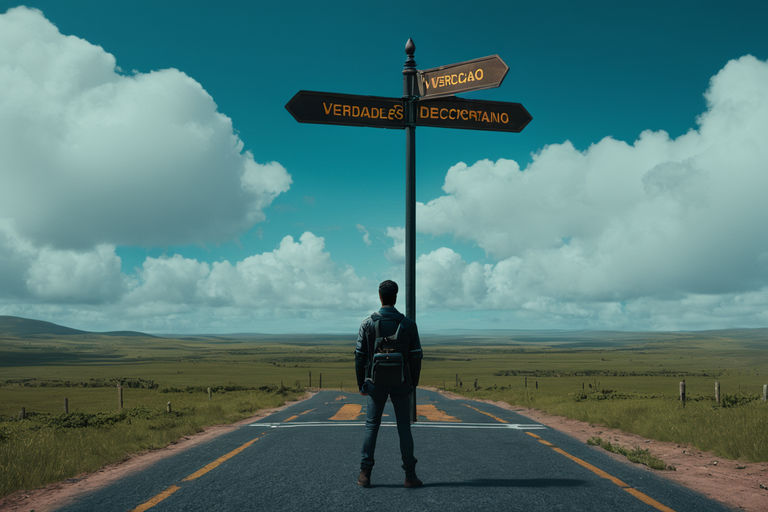The image of “A person standing at a crossroads” encapsulates a moment rife with potential and ambiguity. This imagery resonates across cultures and epochs, symbolizing critical junctures in life where choices bear significant consequences. As perennially depicted in art and literature, the concept evokes universal themes of decision-making, self-discovery, and temporal fluidity, allowing a reflective examination of why such representations are so profoundly captivating.
The crossroads serve as a metaphor for life’s multifaceted pathways. It invokes the notion that existence is not linear but rather a labyrinth of choices, each leading to divergent outcomes. This conceptualization of life transforms a simple setting into an emblem of existential deliberation. At a crossroads, the individual finds themselves at a pivotal moment; the left may signify the safe yet mundane route, while the right offers the allure of adventure, albeit accompanied by uncertainty.
Historically, the crossroads has been employed in various narratives as a motif for choice and moral dilemmas. In ancient folklore, such locations were often seen as enchanted or imbued with supernatural significance. Many cultures regarded crossroads as liminal spaces—thresholds between the known and the unknown. Here, the possibility of divine intervention seemed palpable, with deities or spirits purportedly influencing the decisions made at these intersection points.
Philosophically, standing at a crossroads evokes the existential angst articulated by thinkers like Soren Kierkegaard and Jean-Paul Sartre, who posited that choice is intrinsically linked to our freedom and, consequently, our burden. Choosing one path necessitates forsaking another, thus engendering feelings of regret or elation based on the outcomes of those choices. This fundamental aspect of human existence—decision-making under uncertainty—is a riveting psychological conundrum. It speaks to the tension between the desire for control over one’s destiny and the acknowledgment of the chaotic variables that life invariably thrusts upon the individual.
Furthermore, the motif transcends mere individualism. The crossroads may symbolize collective transitions as well, particularly in the context of societal movements. For instance, moments of historical upheaval—such as civil rights struggles or cultural revolutions—often reflect a community of individuals standing at a collective crossroads, grappling not only with personal choices but with societal implications. The decisions made can wield profound effects on the zeitgeist, shaping norms, values, and communal identities.
In literature, the crossroads motif is elegantly captured in various narratives. Iconic works such as Robert Frost’s “The Road Not Taken” underscore the profound nature of choice. Frost’s allegorical fork in the woods speaks to the inherent complexity and inevitable contemplation surrounding decisions that shape our life trajectories. Through these literary lenses, the crossroads become an archetype, representing more than just physical intersections but rather complex landscapes of thought and introspection.
Artistically, this imagery allows for profound interpretation. The solitary figure at the crossroads can convey feelings of isolation amidst overwhelming choices. Visual representations often highlight the juxtaposition between the figure and the converging paths, amplifying a sense of vulnerability. Artists leverage this tension to evoke in viewers a visceral understanding of the weight that choices carry—the emotional investment in potential futures and the haunting specter of what might have been.
Additionally, culturally, the concept of the crossroads resonates with narrative traditions from diverse societies. In Native American folklore, for instance, the imagery reflects a balance between forces of nature and humankind’s agency. The acknowledgment of choice is not merely personal but connected to a greater cosmic web of interrelations, wherein the implications of one person’s decision can ripple through the fabric of interconnected lives.
Moreover, the contemporary digital landscape has redefined the nature of crossroads. In an era marked by rapid change and an overwhelming influx of information, individuals continuously encounter virtual junctions. Social media platforms, for instance, present a myriad of choices regarding identity presentation, relationships, and belief systems. Here, the crossroads morph into an almost metaphorical digital landscape where decisions are not solely personal but also have public implications that reverberate through social networks.
Psychologically, the moment of standing at a crossroads can induce a powerful introspective journey. It allows for self-examination and, often, a reevaluation of life goals, values, and aspirations. The contemplation requires navigating not only fears and uncertainties but also reaffirming one’s agency. Engaging with this metaphor allows individuals to confront innate desires, societal expectations, and the essence of their authentic selves.
The archetype of the crossroads embodies the multifaceted nature of human experience—where every decision encapsulates potential, apprehension, and evolution. Both a personal and collective symbol, it invites us to reflect deeply on the narratives of choice that shape our lives. As society continually finds itself at various crossroads, from personal dilemmas to global challenges faced by communities, the metaphor persists, urging an exploration of the myriad paths ahead.
Ultimately, “A person standing at a crossroads” serves as a prism through which myriad themes of choice, identity, and the interplay between freedom and fate are illuminated. This enduring motif resonates because it encapsulates the complexity of human existence—a tapestry woven from countless decisions, each path representing a unique facet of life’s journey.
